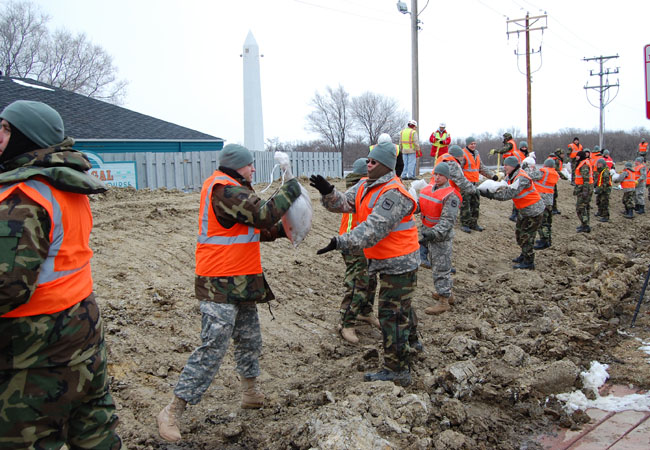
Filling Sandbags
- Team member 1 holds and empty sandbag open on the ground in front of his or her feet.
- Team member 2 empties shovelfuls of sand (or dirt or gravel) into the open bag, until the bag is 1/3 to 2/3 full.
- Team member 3 stacks and stockpiles the filled sandbags.
Sandbags do not need to be tied, although they can be tied loosely at the top. Untied sandbags form a tighter seal when stacked.
For larger operations, bag-holding racks, funnels on the back of trucks and other power-loading equipment (if available) may be used to speed the process.
*******************************
Sandbags are typically moved using a passing line.
To set up a diagonal-passing line:
- Team members stand side-by-side in a line.
- every second team member takes a small step back.
- Unmoved team members turn around to face the members who took a step back.
Use your knees and not your back when lifting sandbags.
When constructing a barrier on an incline, taller team members should be at the end of the line that is farthest from the barrier.
*******************************
Building a Sandbag Barrier
- Clear any debris from the area where sandbags are to be placed.
- Dig a trench for to six inches deep and two sandbags wide.
- Line the trench with heavy duty plastic (poly), extending the plastic across the trench and away from the bottom row of sandbags and toward the water.
- Place a row of sandbags length-ways and parallel to the direction of the flow around the edge of the plastic to anchor it. Overlap sandbags, tucking the open end under the bottom end of the next sandbag.
- Stagger the second layer of bags perpendicular to the first layer. Layer the barrier like a bric wall with each sand bag overlapping the one below by half.
- Stamp sandbags firmly into place to eliminate gaps and create a tight seal.
- Roll the plastic over the anchoring row of sandbags and anchor again.
- Place additional layers of sandbags in alternating directions.
- Once the barrier is at the appropriate level, fold the plastic over the top of the barrier and anchor it with extra sandbags.

Barriers more than three layers high should be layered in a pyramid structure using a ratio of 3:1. For every foot in height, the base must be three feet wide.
Information obtained from Salt Lake CERT Field Operations Guide.



